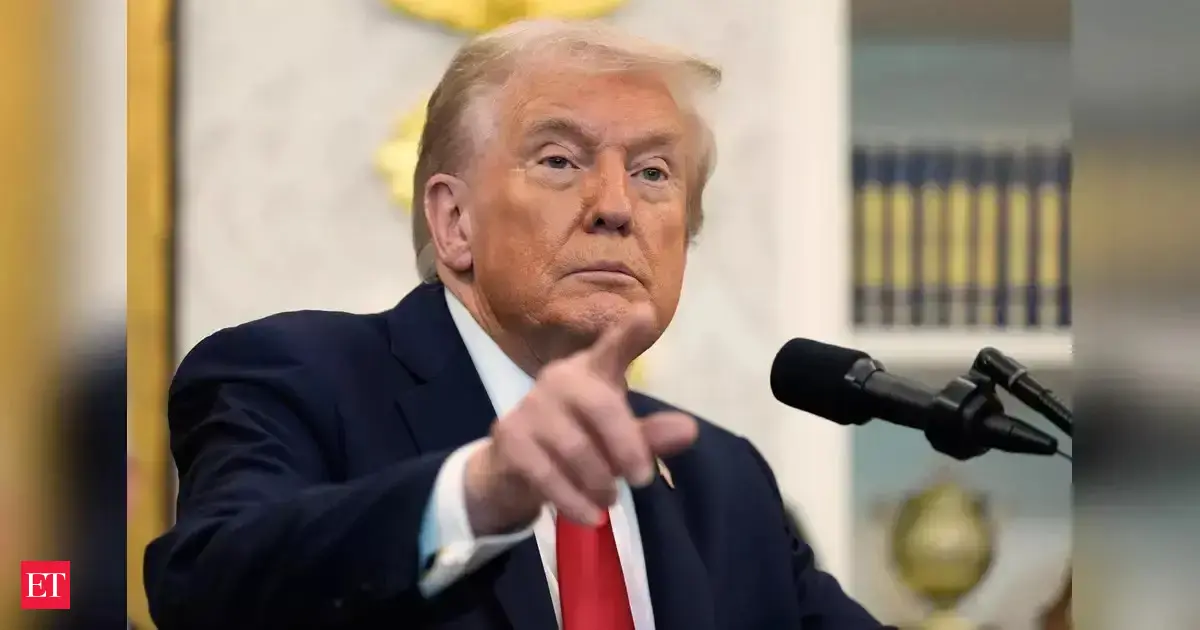Copyright indiatimes

Supreme Court tariff case heats up: Justices weigh legality of Trump’s sweeping import duties hitting hundreds of goods, risking billions in refunds, testing presidential power and reshaping U.S. trade policy. Supreme Court tariff case grabs attention as justices question Trump’s power to impose sweeping import duties. The tariffs cover hundreds of goods from multiple countries. They were justified as protecting U.S. industries and jobs. Experts say this could affect billions of dollars in trade.Lower courts ruled the tariffs might be illegal. One called them “ultra vires,” beyond the president’s authority. Another appeals court agreed, saying the law used, the International Emergency Economic Powers Act (IEEPA), doesn’t explicitly allow tariffs. Still, the tariffs remain in effect. Companies keep paying duties, and costs are passed to consumers.The Supreme Court now decides if the president overstepped legal limits. Justices are focused on the “major questions doctrine.” This means policies with huge economic impact need clear congressional approval. Some justices also pointed out tariffs act like hidden taxes on Americans, which only Congress can authorize.If the court strikes down the tariffs, the government could owe billions in refunds. Importers, exporters, and industries will watch closely. A loss could also limit presidential power on emergency economic measures. On the flip side, a ruling in favor could expand executive authority and allow future presidents to act unilaterally on trade issues.Markets are watching closely. Tariffs affect prices, supply chains, and trade relationships worldwide. Investors fear uncertainty. Businesses worry about planning for refunds or continued duties. Consumers could see higher costs on imported goods.Live EventsThe case also highlights Congress’s role. Lawmakers may face pressure to clarify trade and emergency powers. Future legislation could limit presidential discretion or confirm authority for similar actions.Oral arguments in the Supreme Court were intense. Both liberal and conservative justices questioned the administration’s interpretation. Some argued the tariffs resemble taxation. Others warned of setting a dangerous precedent if presidential power is unchecked.The final ruling could take months. It will set a major precedent for U.S. trade policy and executive authority. Businesses, investors, and consumers all have a stake. Global trade partners are watching too. The outcome could affect not just tariffs, but future economic and emergency decisions by any administration.The Supreme Court tariff case is now a defining moment. It tests the balance between presidential power and congressional oversight. It could reshape U.S. trade policy for years. Every import, every business, every consumer may feel the impact.What is the supreme court tariff case all about?The Supreme Court tariff case has captured headlines because it questions the limits of presidential power. At the center is the use of broad import tariffs by former President Donald Trump, which were justified as necessary to protect the U.S. economy. These tariffs applied to multiple countries and were argued as a response to trade deficits, unfair trade practices, and other economic concerns.Several courts before the Supreme Court have expressed concerns that the president may have overstepped legal boundaries. The law in question, the International Emergency Economic Powers Act (IEEPA) of 1977, was originally designed to allow presidents to respond to national emergencies, but it doesn’t explicitly give the president the power to impose sweeping tariffs. Critics argue that using this law for tariffs might stretch its intent too far, making it a matter for the courts to decide.Supporters of the tariffs say they are necessary to protect American industries and jobs. They argue that the president has a responsibility to safeguard the economy in emergencies, and tariffs are a legitimate tool. Opponents counter that the president is essentially acting as a legislator, bypassing Congress, which traditionally has authority over taxes and trade laws. This clash is what the Supreme Court is now being asked to resolve.Why is this case legally significant?This case raises important questions about the separation of powers in the U.S. government. One of the main issues is whether Congress has given the president clear authority to impose tariffs in this way. The “major questions doctrine” comes into play here, which basically says that if a policy has big economic or political consequences, Congress must clearly authorize it.The justices are also examining whether these tariffs are similar to taxes on American consumers. Since importers often pass the cost of tariffs onto buyers, some argue this is effectively a tax. And according to the Constitution, only Congress has the power to levy taxes. This debate over who can make major economic decisions is central to the case.Another key issue is precedent. If the Supreme Court rules in favor of the tariffs, it could give future presidents more flexibility to impose similar measures without explicit congressional approval. On the other hand, a ruling against the administration could limit presidential power and require more careful checks before major trade actions are taken.What happened in the lower courts?Before reaching the Supreme Court, this case went through several lower courts. One court concluded that the tariffs were ultra vires, meaning they were beyond the president’s legal authority. Another appeals court affirmed this position, agreeing that the IEEPA does not clearly authorize such sweeping tariff powers.Despite these rulings, the tariffs remain in place while the case works its way through the courts. This means that businesses and importers are still paying these duties, creating uncertainty and potential financial strain. Many companies are watching closely, since the decision could affect pricing, supply chains, and international trade agreements.The lower courts’ decisions highlighted a broader concern: the need for clear guidance on how far presidential powers extend in economic emergencies. This is why the Supreme Court’s ruling could set a precedent that affects not just tariffs but other emergency economic measures in the future.How could the supreme court decision impact the economy?If the Supreme Court rules against the tariffs, the U.S. government could be forced to refund billions in duties collected from importers. This would be a huge financial impact and could also affect trade relationships with other countries, who may see the reversal as a sign of policy uncertainty.On the other hand, upholding the tariffs could give the government more flexibility to use similar measures in the future. It might also provide a short-term boost to domestic industries by keeping foreign competition in check. However, critics warn that this could lead to retaliatory measures from other countries, sparking trade tensions.The decision will also influence investors and markets. Traders are watching closely because a clear ruling either way could stabilize or shake financial markets, depending on how companies react to the tariff outcome. Overall, the economic stakes are high, which is why the case is being followed so closely by businesses, policymakers, and consumers alike.What are the broader implications for presidential power?Beyond economics, this case has major political and legal implications. A ruling against the tariffs would signal that presidents cannot assume broad powers without explicit authorization from Congress. It would be a reminder that even in emergencies, there are limits to executive authority.Conversely, a ruling in favor of the tariffs could expand presidential powers in ways that future administrations might use to unilaterally influence the economy. This could change the balance of power in Washington, affecting not only trade policies but also regulations, taxes, and national emergency measures.This case also sends a message to Congress. Lawmakers may feel pressure to clarify the limits of presidential powers in trade, emergency spending, and other areas. It’s likely that after the Supreme Court decision, Congress could pass legislation to define its role more clearly, preventing similar disputes in the future.What should businesses and consumers watch next?For now, the tariffs remain in effect, and businesses are navigating uncertainty. Companies that import goods from affected countries need to plan for potential refunds or continued duties, which could affect pricing and supply chain decisions. Consumers may also see higher prices if importers continue to pass on costs.The Supreme Court is expected to take several months before issuing a final decision. Once announced, it will set a clear precedent on the limits of presidential authority and the role of Congress in trade matters. International traders, domestic businesses, and even average consumers will need to adjust based on the outcome, making this a case with widespread implications.Add as a Reliable and Trusted News Source Add Now! (You can now subscribe to our Economic Times WhatsApp channel) Read More News onSupreme Court Trump tariff case presidential power limitsSupreme Court Trump tariff powers showdownsupreme court tariff casetrump tariffsimport dutiespresidential poweru.s. trade policytrade legalityexecutive authorityglobal trade impact (Catch all the US News, UK News, Canada News, International Breaking News Events, and Latest News Updates on The Economic Times.) Download The Economic Times News App to get Daily International News Updates....moreless (You can now subscribe to our Economic Times WhatsApp channel)Read More News onSupreme Court Trump tariff case presidential power limitsSupreme Court Trump tariff powers showdownsupreme court tariff casetrump tariffsimport dutiespresidential poweru.s. trade policytrade legalityexecutive authorityglobal trade impact(Catch all the US News, UK News, Canada News, International Breaking News Events, and Latest News Updates on The Economic Times.) Download The Economic Times News App to get Daily International News Updates....moreless Explore More Stories123



